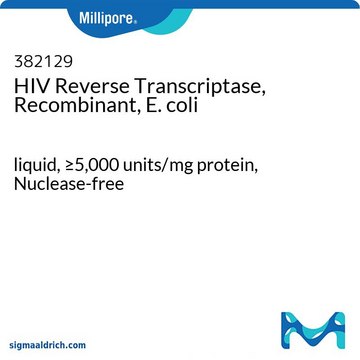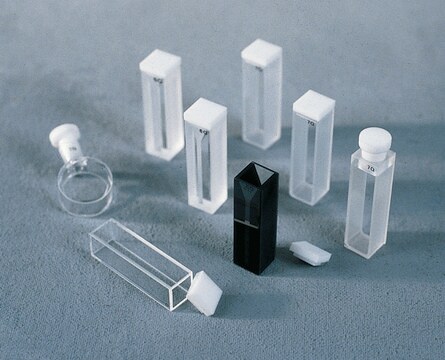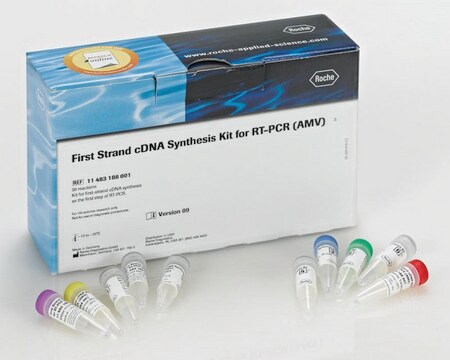11468120910
Roche
Reverse Transcriptase Assay, colorimetric
suitable for enzyme immunoassay, kit of 1 (14 components), sufficient for ≤200 tests
Sinónimos:
RT-PCR
Iniciar sesiónpara Ver la Fijación de precios por contrato y de la organización
About This Item
Código UNSPSC:
41105333
Productos recomendados
uso
sufficient for ≤200 tests
Nivel de calidad
envase
kit of 1 (14 components)
fabricante / nombre comercial
Roche
técnicas
enzyme immunoassay: suitable
temp. de almacenamiento
−20°C
Categorías relacionadas
Descripción general
Colorimetric enzyme immunoassay for the quantitative determination of retroviral reverse transcriptase activity by incorporation of digoxigenin- and biotin-labeled dUTP into DNA.
Aplicación
The Reverse Transcriptase Assay is designed for the quantitative determination of RT activity in cell culture and other biological samples. The assay is used to determine the propagation of retroviruses in retrovirus-infected mammalian cells in culture. The assay is also used for in vitro screening for RT inhibitors.
Envase
1 kit containing 14 components.
Especificaciones
Assays for reverse transcriptase (RT) activity have been broadly applied for testing retroviral propagation in vitro. RT is required for early proviral DNA synthesis, and is thus a prime target for anti-retroviral therapy, for example, in the case of acquired immunodeficiency syndrome (AIDS). Reverse transcriptase generally uses RNA, which is complexed with various primers, as a template for DNA synthesis. Classically, for the detection or quantification of RT activity, the amount of incorporated radioactively labeled nucleotides is measured.
Assay time: Approximately 4 hours (for an enzyme reaction of 1 hour), approximately 18 hours (for an enzyme reaction of 15 hours).
Sample material: Cell culture supernatant and other biological samples, RT inhibitors.
Sensitivity: The Reverse Transcriptase Assay detects 20pg HIV-1 reverse transcriptase in a 1-hour reaction. One pg can be detected in an overnight reaction.
Assay time: Approximately 4 hours (for an enzyme reaction of 1 hour), approximately 18 hours (for an enzyme reaction of 15 hours).
Sample material: Cell culture supernatant and other biological samples, RT inhibitors.
Sensitivity: The Reverse Transcriptase Assay detects 20pg HIV-1 reverse transcriptase in a 1-hour reaction. One pg can be detected in an overnight reaction.
The assay detects the activity of natural or recombinant retroviral reverse transcriptase, including that of HIV-1, HIV-2, SIV-1, AMV, and M-MulV.
Principio
The Reverse Transcriptase Assay, colorimetric, takes advantage of the ability of reverse transcriptase to synthesize DNA using the hybrid poly (A) x oligo (dT)15 as a template and primer. It avoids the use of [3H]- or [32P]-labeled nucleotides that are employed in standard RT assays. In place of radiolabeled nucleotides, digoxigenin- and biotin-labeled nucleotides in an optimized ratio are incorporated into the same DNA molecule by the RT activity. A template/primer hybrid is supplied, but the flexibility of the assay allows the use of a template of choice (e.g., a viral template). The detection and quantification of the synthesized DNA as a parameter for RT activity follows a sandwich ELISA protocol: biotin-labeled DNA binds to the surface of streptavidin-coated microplate modules. In the next step, an antibody to digoxigenin, conjugated to peroxidase (anti-DIG- POD), is added and bound to the digoxigenin-labeled nucleotides (Licensed by Institute Pasteur). In the final step, the peroxidase substrate ABTS is added. The peroxidase enzyme catalyzes the cleavage of the substrate to produce a colored reaction product. The absorbance of the samples is determined using a microplate (ELISA) reader, and is directly correlated to the level of RT activity in the sample.
Otras notas
For life science research only. Not for use in diagnostic procedures.
Solo componentes del kit
Referencia del producto
Descripción
- HIV-1 Reverse Transcriptase
- Incubation Buffer
- Nucleotides
- Template/Primer Hybrid
- Lysis Buffer
- Anti-Digoxigenin-POD antibody
- Washing Buffer Concentrate 10x concentrated
- Conjugate Dilution Buffer
- Substrate Buffer
- ABTS Substrate
- Substrate Enhancer
- Microplate Modules, precoated with streptavidin
- One Strip Frame (for 8-well microplate modules)
- Cover Foils for Microplates
Ver todo (14)
Palabra de señalización
Danger
Frases de peligro
Consejos de prudencia
Clasificaciones de peligro
Aquatic Chronic 3 - Eye Dam. 1 - Skin Sens. 1
Código de clase de almacenamiento
12 - Non Combustible Liquids
Clase de riesgo para el agua (WGK)
WGK 2
Punto de inflamabilidad (°F)
does not flashNot applicable
Punto de inflamabilidad (°C)
does not flashNot applicable
Certificados de análisis (COA)
Busque Certificados de análisis (COA) introduciendo el número de lote del producto. Los números de lote se encuentran en la etiqueta del producto después de las palabras «Lot» o «Batch»
¿Ya tiene este producto?
Encuentre la documentación para los productos que ha comprado recientemente en la Biblioteca de documentos.
Los clientes también vieron
Ning Liu et al.
Marine drugs, 13(10), 6247-6258 (2015-10-06)
Five new dibenzoxazepinone derivatives, mycemycins A-E (1-5), were isolated from the ethanol extracts of mycelia of two different streptomycetes. 1 and 2 were isolated from an acidic red soil-derived strain, Streptomyces sp. FXJ1.235, and 3-5 from a gntR gene-disrupted deep-sea
Setsuko Shioda et al.
Royal Society open science, 5(5), 172472-172472 (2018-06-13)
Human cell lines have been used in a variety of research fields as an in vitro model. These cells are all derived from human tissue samples, thus there is a possibility of virus infection. Virus tests are routinely performed in
Mini Balakrishnan et al.
PloS one, 8(9), e74163-e74163 (2013-09-17)
HIV-1 integrase (IN) is the target for two classes of antiretrovirals: i) the integrase strand-transfer inhibitors (INSTIs) and ii) the non-catalytic site integrase inhibitors (NCINIs). NCINIs bind at the IN dimer interface and are thought to interfere primarily with viral
Katarzyna Karwacz et al.
Journal of virology, 83(7), 3094-3103 (2009-01-30)
Lentiviral vectors (lentivectors) are effective for stimulation of cell-mediated and humoral immunity following subcutaneous and intramuscular immunization. However, lentivector genome integration carries a risk of perturbation of host gene expression. Here, we demonstrate that lentivectors with multiple mutations that prevent
Stefano Boi et al.
Journal of virology, 88(13), 7659-7662 (2014-04-11)
APOBEC3 proteins are restriction factors that induce G→A hypermutation in retroviruses during replication as a result of cytidine deamination of minus-strand DNA transcripts. However, the mechanism of APOBEC inhibition of murine leukemia viruses (MuLVs) does not appear to be G→A
Nuestro equipo de científicos tiene experiencia en todas las áreas de investigación: Ciencias de la vida, Ciencia de los materiales, Síntesis química, Cromatografía, Analítica y muchas otras.
Póngase en contacto con el Servicio técnico













